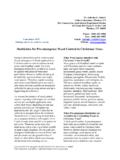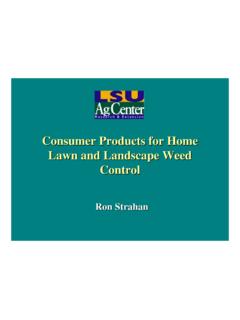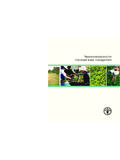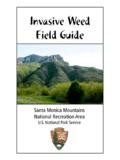Transcription of January 2014 ChemCert - Chemical Accreditation
1 ChemCertUsers Guide to weed control in Public Places January 2014 2 Council Guide to weed control in Public PlacesChemCert Freecall 1800 444 228 IndexIntro 3 A requirement to control noxious weeds 4 Notification Public authorities 4Re-Entry 4 Personal Protection Equipment 5 Safe and Lawful Storage of Pesticides 6 Decanting 6 Record Keeping 7 Safety Data Sheets for Hazardous Chemicals 8 Managing Glyphosate Resistsance 8 Users Guide to weed control in Public Places ChemCertFreecall 1800 444 228to enrol Guide to weed control in Public Places3 ChemCert Freecall 1800 444 228 Jonathan was appointed as Course Developer for ChemCert Training Group in 2009 and has developed the industry standard ChemCert AQF III course widely delivered throughout AustraliaJonathan has extensive knowledge in spray application techniques gained through his experience as a sheep, beef and deer farmer and Spray Nozzle technician at Silvan Australia.
2 Jonathan and all ChemCert trainers aim to help spray applicators limit the amount of pesticides which drift off target, affecting the environment and potentially creating residue issues, through a proactive approach to spraying and a heightened awareness of was appointed as the Head Trainer for ChemCert Training Group in 2011 and is serious about ensuring your ChemCert trainer is qualified and knowledgeable to provide you with the latest up to date information. Regarded as a leader within the agricultural industry, Alan possesses a wealth of knowledge about chemicals through his experience as a farmer, member of council and various Chemical boards and committees. His experience has led him to acquire knowledge about the development of State and Federal Chemical use policy.
3 Alan s key area of expertise is risk management, gained through his roles as a farmer and Group Captain of the Rural Fire Service. Alan works with his community to reduce the likelihood of risks and hazards by focusing on risk reduction. Risk Jonathan Pearson Course Developer / Trainer / AssessorAlan Brown Head Trainer / ChemCert Council Guide to weed control in Public Places has been designed to address many of the key issues councils face when managing weeds in public places including the Work Health and Safety (WHS) concerns of their workers and environmental guide will help you to effectively manage herbicide resistance, meet your waste reduction targets, and adhere to your environmentally sustainable policies.
4 By using this guide your spraying activities will be more efficient and safe for your workers and members of the community. In a ChemCert Course, your workers will learn the critical components of weed control from rotating herbicide mode of action groups to assessing the toxicity of pesticides via the product label and the Safety Data Sheet (SDS).Other key issues that your workers will learn: Re-entry intervals in public places Notification and safety directions for workers Environmental protection statements and restraints Resistance management strategies and non- Chemical control options that can be incorporated into an integrated weed management approach How to meet waste reduction targets via equipment calibration and observance of weather forecasts How to select the correct nozzles and equipment set up to control and reduce spraydrift The disposal of drums and pesticides through the DrumMuster and ChemClear waste management hope that you find this guide a vital asset in managing weeds in public places within your area and we thank you for
5 Your 4 Council Guide to weed control in Public PlacesChemCert Freecall 1800 444 228A Requirement to control Noxious WeedsThe Noxious Weeds Act 1993 forces land occupiers (including councils) to control noxious weeds declared for their area. Noxious weed control delivers community benefits, protects biodiversity and reduces the potential spread to neighbouring properties. Neighbourly relations can turn hostile when one party doesn t control invasive weeds and the weeds spread onto the adjacent property of their occupiers have a responsibility to control declared noxious weeds of class 1,2 and 3, with councils also having a dual role involving both land they occupy as well as contributing to the development of regional weed management and natural resource plans and strategies.
6 Notification Public AuthoritiesPublic authorities including state government departments, local and county councils require notification plans that describe how they will provide the public with notice about their pesticide use in outdoor public places such as parks and ovals, and near sensitive sites such as schools and during spraying varies amongst councils but is often as simple as:Re-EntryMany pesticide labels that pose some risk to human health have as a default a statement saying to not re-enter the sprayed area without appropriate PPE until the spray has dried on the target weed , DO NOT allow entry into treated crops until spray deposits have dried. If prior entry is required, limit duration of entry and wear cotton overalls buttoned to the neck and wrist (or equivalent clothing) and Chemical resistant gloves.
7 Clothing must be laundered after each day s , A WONS, weed of National SignificanceDANGERSPRAYING IN PROGRESS32 Weeds of National Significance africanboxthorn, alligatorweed, asparagus-weeds, athelpine, bellyachebush, bitoubush, blackberry, bridalcreeper, brooms, cabomba, catsclawcreeper, Chileanneedlegrass, fire- weed , gambagrass, gorse, hymenachne, lantana, madeira vine, mesquite, mimosa, opuntioidcacti, Parkinsonia, parthenium, pondapple, pricklyacacia, rubbervine, sagittaria"salvinia"serratedtussock "silverleafnight-shade" waterhyacinth" "willows" Council Guide to weed control in Public Places5 ChemCert Freecall 1800 444 228 Powder Inhalation into the respiratory systemSome basic equipment used during mixing and application.
8 Overalls, Nitrile gloves, cartridge respirator and a thick beard will break the air tight seal between the face and respirator making the use of the respirator Protection Equipment (PPE)Mixing of Chemical concentrates represents the most hazardous time when using pesticides and so mixing should be carried out wearing rubber boots, a Chemical apron, elbow - length gloves and a face-shield or safety goggles as a default, but again follow the label safety directions for the actual PPE required for each specific Chemical . Remember that a respirator will be specified when using powder formulations because of the inhalation and application PPE for most glyphosate formulations, being of low toxicity, are limited to statements such as;SAFETY DIRECTIONS (Roundup label)Product will irritate the eyes and skin.
9 Avoid contact with eyes and skin. When preparing the product for use, wear elbow-length PVC gloves and face shield or goggles. After use and before eating, drinking or smoking, wash hands, arms and face thoroughly with soap and water. After each day's use wash contaminated clothing, gloves and face shield or goggles. When using controlled droplet applicator, wear protective waterproof clothing and impervious footwear. Each pesticide user should have their own set of PPE for personal hygiene reasons, with all the necessary protection equipment to cover the label safety directions specified for each Chemical used, for both mixing and charcoal filters for air conditioned tractor cabs should be checked regularly, with many having a red indicator gauge to alert you of Guide to weed control in Public PlacesChemCert Freecall 1800 444 228 Remember to also check as to whether any stored chemicals are Dangerous Goods (DG s), identified by a colour diamond on the label if they are a DG (explosive, corrosive, flammable ,toxic etc.)
10 The class number is found in the diamond, and together with the packing group gives you the storage thresholds (placards) for DG sDecanting (transferring from one container to another)Decanting should be kept to a minimum because of the difficulty of maintaining identification of decanted contents in new containers, unless used immediately. An example of immediate use is when measuring out an amount and pouring it directly into a spray pesticide should be decanted only into another container designed for the pesticide. Some pesticides can react with the container if the wrong type of container is t transfer pesticides from one container to another unless both containers are properly of DG Diamonds with class numbers seen down the bottom of the of a basic Chemical storage floor through grate with ground level cross airflow and also absorbent material.






